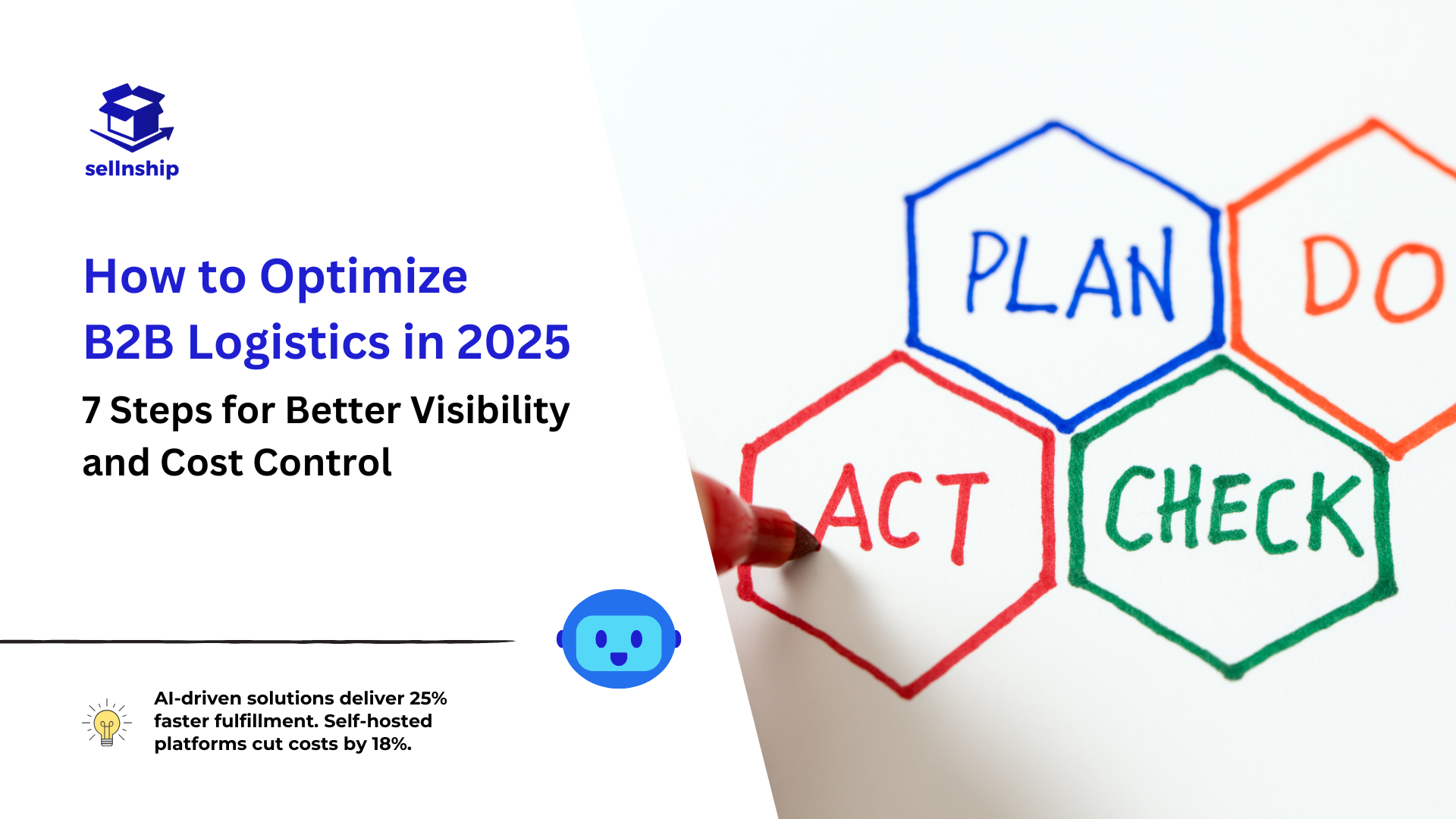How to Optimize B2B Logistics in 2025: 7 Steps for Better Visibility and Cost Control

In 2025, B2B logistics face intense pressure. Tariffs, supply chain disruptions, and rising fuel costs demand smarter solutions. Companies seek real-time visibility, cost efficiency, and flexibility without vendor lock-in. This guide delivers actionable steps to optimize your fulfillment operations, leveraging AI, self-hosted systems, and data-driven strategies. Let’s dive into how you can transform your B2B logistics for scalability and resilience.
Step 1: Pinpoint Your Logistics Challenges
Start with a clear picture of your pain points. Many B2B firms struggle with poor consignment visibility (40% report this issue). Labor shortages delay quick commerce. Fuel and maintenance costs are up 15-20%. Ask: Are shipments tracked in real-time? Can your system handle tariff-driven smaller shipments? Is data secure?
Actionable Tip: Conduct a SWOT analysis focused on your supply chain. Set SMART goals, like cutting fulfillment errors by 30% or hitting 99% on-time delivery. Use analytics tools to baseline performance securely on your infrastructure.
Step 2: Leverage AI for Smarter Decisions
AI is critical in 2025 logistics. Over 70% of B2B companies prioritize it for inventory forecasting and route optimization. Predictive models cut stockouts. Dynamic routing saves up to 25% on fuel. Automated client updates reduce communication complaints, a top issue for 35% of stakeholders.
How to Start:
- Predictive Inventory: Use historical order data to forecast demand. Ensure compliance with regulations like the EU Data Act by processing data in-house.
- Route Optimization: Address urban congestion with real-time adjustments.
- Anomaly Detection: Integrate IoT sensors to flag disruptions early.
| AI Tool | Benefit | Implementation Tip |
|---|---|---|
| Demand Forecasting | Cuts overstock by 20-30% | Use secure, in-house analytics |
| Dynamic Routing | Boosts delivery speed by 15% | Customize for pallet shipments |
| Anomaly Detection | Spots issues early | Pair with warehouse IoT |
Step 3: Adopt Self-Hosted Systems for Control
Vendor lock-in is a growing concern. B2B searches for “self-hosted logistics software” are spiking as firms demand data ownership. Self-hosted platforms let you run operations on your cloud (AWS, Azure, or private). This avoids SaaS dependencies and boosts cybersecurity—a top priority in 2025.
Steps to Transition:
- Pilot First: Test high-volume SKUs to minimize downtime.
- Secure Data: Use end-to-end encryption and role-based access to counter cyber threats.
- Go Green: Optimize loads to cut emissions, aligning with ESG goals.
Self-hosted systems save 18% on costs and future-proof against trade volatility, a worry for 60% of logistics leaders.
Step 4: Integrate Systems for Seamless Workflows
Silos kill efficiency. Hyperautomation and digital twins are trending to unify operations. Seamless ERP and CRM integration ensures smooth data flow. APIs connect your warehouse, sales, and customer portals. This reduces delays and boosts order accuracy.
Pro Tip: Choose platforms with open APIs for flexibility. Avoid rigid 3PL systems that limit customization.
Step 5: Upskill Teams for AI and Automation
Labor shortages make training non-negotiable. Intuitive dashboards cut training time by 50%. Upskill staff on AI tools like inventory forecasting. Foster a culture of continuous improvement. Regular training ensures your team maximizes new tech.
Quick Win: Start with short, role-specific training modules. Focus on high-impact areas like real-time tracking.
Step 6: Monitor KPIs and Iterate
Track metrics like order accuracy, cycle time, and delivery rates. Review quarterly to spot trends, such as tariff impacts on routing. Use customizable reports to stay agile. B2B logistics thrive on data-driven iteration.
Tool Tip: Deploy analytics platforms that run on your servers for data privacy. This aligns with 2025’s focus on secure, in-house processing.
Step 7: Build Resilient Partnerships
Collaboration is key. Share real-time data with suppliers and carriers. Use digital platforms to align on delivery windows. This tackles the 35% of B2B complaints tied to poor communication. Resilient partnerships absorb shocks from global trade shifts.
Actionable Step: Implement shared dashboards for stakeholders. Ensure data stays on your infrastructure for security.
B2B logistics is evolving fast. AI-driven solutions deliver 25% faster fulfillment. Self-hosted platforms cut costs by 18%. Companies prioritizing visibility and control outperform competitors. With tariffs and sustainability pressures rising, now’s the time to act.
Next Steps: Audit your operations today. Explore self-hosted AI platforms that offer flexibility and data ownership. Share your biggest logistics challenge below—we’d love to hear your thoughts!